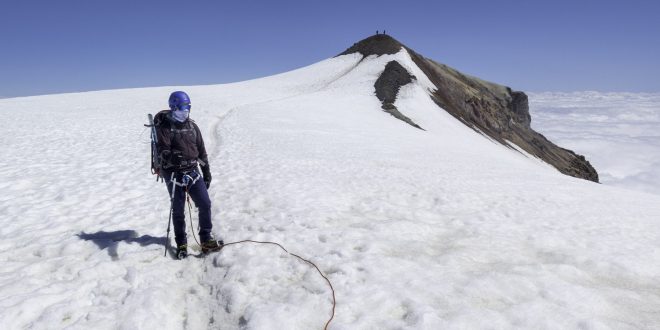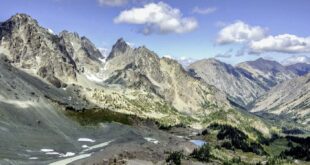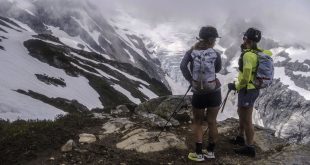Everything feels familiar driving up Glacier Creek Road to the Heliotrope Ridge trailhead. I’ve been backpacking for decades, to more trailheads than I could possibly remember, and I’ve been on this trail on more than one occasion. But today is different. For the first time, my goal is the summit of Mt. Baker.
We shoulder our packs and start hiking, just as I’ve done so many times before. Jere Burrell, owner of Guided Exposure, sets the pace: slow and steady. Guided Exposure is Jere’s passion, a guide service he founded to “inspire individuals to challenge themselves.”
I briefly glance downslope, then remember that old mantra: don’t look where you don’t want to go.
We take a break sooner than I feel like I need one, but slow and steady will be the theme of the weekend. If all goes well, I’ll be standing on the summit of Mt. Baker in less than 24 hours. I had spent decades camping on, hiking on, and looking at the mountain from nearly every angle. But this was a new experience for me. A loftier goal.
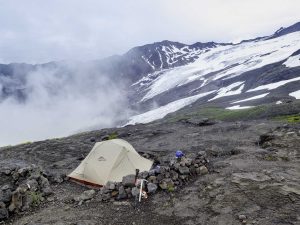
There’s no need to rush. As we saunter up the trail, we talk about our lives and interests, the places we’ve been, and the places we want to go. The three of us have different lifestyles: Jere is a professional adventurer and shares stories of alpine expeditions around the globe; my friend Scott speaks enthusiastically of his love for cycling and tells us about epic rides in Utah and Spain.
My travels and adventures feel stale as I talk about them, mainly having taken place before my oldest son was born seven years ago, and parenting has been a wholly different kind of adventure. I’ve certainly had my share of excitement, but my memories of stimulating travel, exotic destinations, and spontaneous explorations are fading quicker than new ones are replacing them.
But at 40 years old, it’s not too late to rekindle my love for adventure, for the outdoors more generally, and for challenging myself in new ways. Pushing my limits in pursuit of an ambitious goal is almost as much of a draw as the actual summit.
We reach a junction and turn uphill, hiking the steep climber’s route up the Hogsback, leaving the familiar Heliotrope Ridge Trail behind. As we emerge from the trees, alpine flowers line the small creek valleys, and many small streams flow down from the massive snowfields and glaciers above us. Just then, it starts raining, so we continue to base camp without slowing down to savor the colorful splendor. There’ll be time for that later. We reach Hogsback Camp, and Scott and I pitch our tent, while Jere sets up his. My companions each duck into the tents to avoid the rain, but I just pull up the hood on my Gore-Tex shell and sit quietly on a large rock, observing the hustle and bustle of base camp. I had assumed there’d be another dozen or so climbers, but I count nearly 50 tents on this Friday afternoon, sprawled across the undulating landscape.
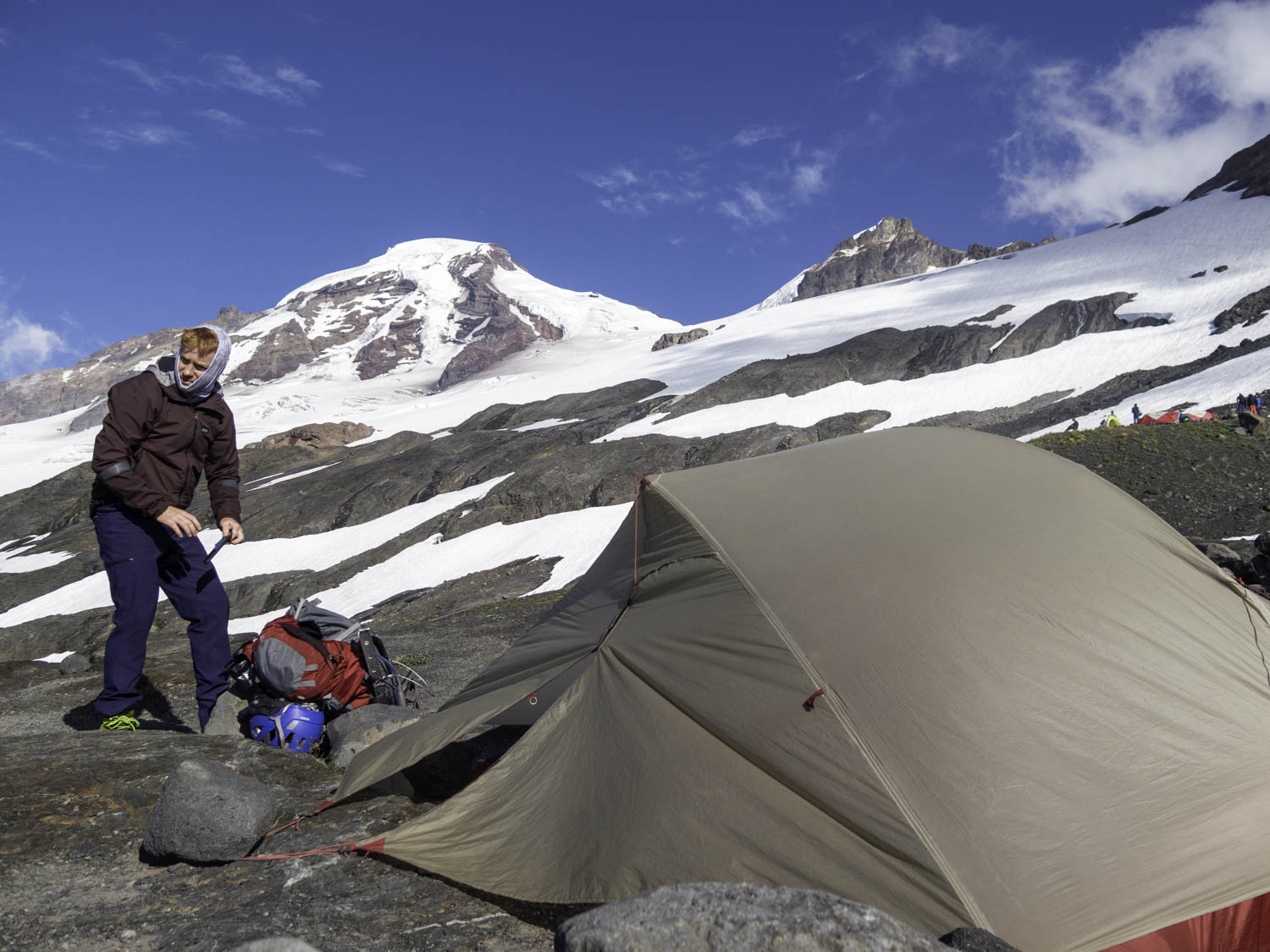
A solitary mountain goat wanders the hillside above our camp. The rain stops, and the sun starts to break through. The view upwards begins to open up. We can’t see the summit yet, but we get glimpses of massive glaciers with yawning crevasses through gaps in the swirling clouds. What I can see looks intense – and foreign. I’m fortunate to have spent so much time in places like this––just above the trees, and just below the glaciers. I’ve always loved this sub-alpine transition zone. On every other trip, this would be the destination. Dinner, sunset, and stars. Then, in the morning, watching the sun burst above the surrounding hillside while enjoying a hot cup of coffee. But this time would be different.
Scott and Jere emerge from their tents, and we walk a short distance to a steeply sloped snowfield to practice for the climb ahead of us. We demonstrate self-arrest with ice axes, setting anchors in the snow, and walking with crampons. No problem. All this comes naturally to us. We stroll back to camp, eat dinner, and get as much sleep as we can before our wake-up call at 3 AM.
3 AM is not my preferred time to wake up, but this morning, the excitement of the climb energizes me. We eat breakfast, pack our summit packs, strap on crampons, slide into harnesses, and rope up. Ice axe in one hand, hiking pole in the other, I start upward toward the glacier, the route illuminated by the flickering light of headlamps.
It’s cold, but there’s nothing quite like walking up a big hill to warm you up. Jere sets the pace: slow and steady, of course. He provides clear instructions on a range of issues, but nothing feels more important than minding the lifeline that connects the three of us: don’t step on the rope; don’t let the rope get tight enough to pull on the person in front of you; don’t walk too fast and allow the rope to go slack. Follow the rope to follow the leader. In this respect, climbing Mt. Baker is simple. Just follow the orange line of rope.
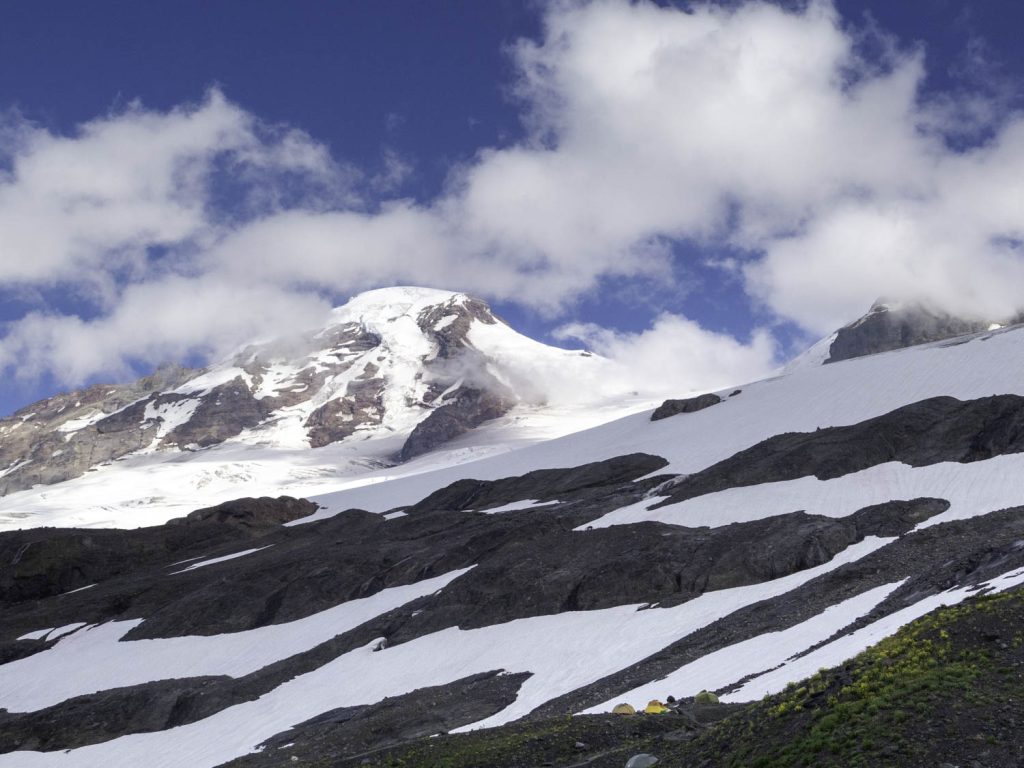
We take a break after fifty minutes and then rest for ten. I turn my headlamp off and slather myself with sunscreen. We hike another fifty and then rest for ten. I have a snack and drink some water. The cycle repeats a few more times, and Jere tells us we’ve reached about 9,000 feet of elevation. I’m surprised to hear that we’ve got less than 2,000 more vertical feet to go. From here, we ascend Pumice Ridge, a column of dirt and rock rising out of the ice. Our crampons continue to provide excellent traction as we navigate the boulders.
Suddenly, we break through the clouds and are bathed in unfiltered sunshine beneath a blue sky. A moderate wind cools us as we transition back from rock to glacier, and we gaze up at a steep 1,000-foot section of the Easton Glacier route ahead of us, the Roman Wall. I know this is the last real push before getting to the top, and I’m feeling strong and confident. It’s a steep pitch, but I trust my team, trust myself, and trust the rope. Jere has an uncanny ability to sense what is happening behind him, and his seemingly casual attitude is helpful. He’s serious and professional, but he’s not worried or stressed. Follow the leader.
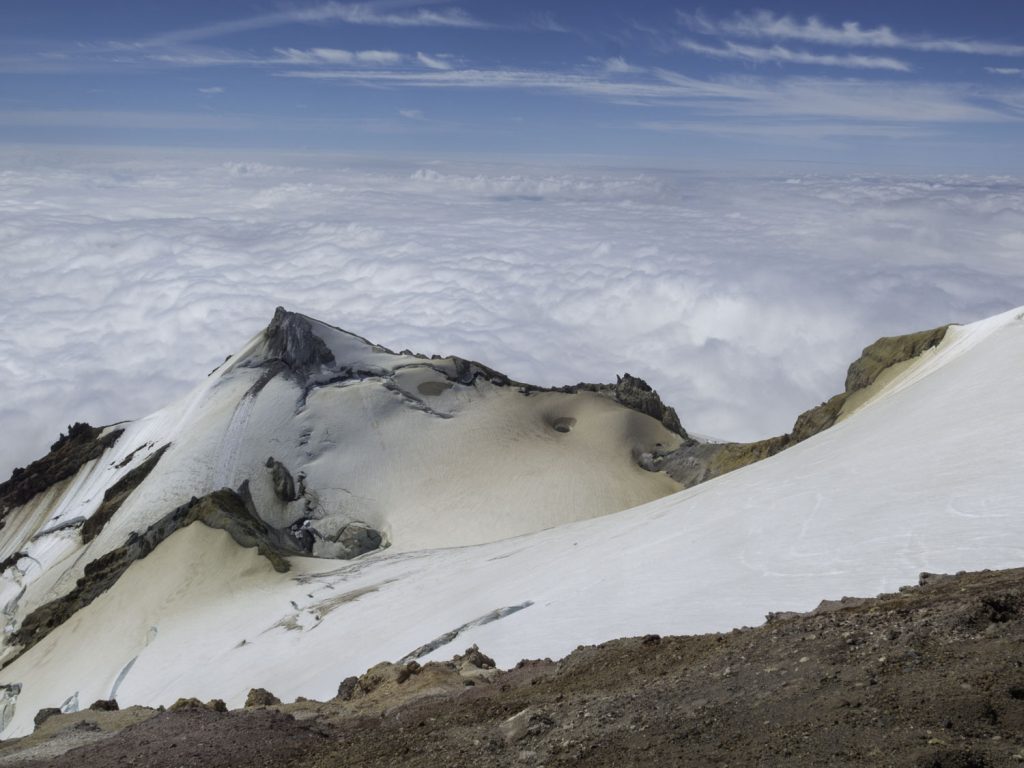
We climb the 700 vertical feet or so of the Roman Wall and get to a bottleneck where we wait for a couple of large groups coming back down from the summit to pass. The narrow route requires traversing across a particularly steep section with a nearly vertical wall on the left and an intimidating drop down to the right. I briefly glance downslope, then remember that old mantra: don’t look where you don’t want to go.
I direct my gaze to the small platform of solid ice where I need to land my left crampon. It’s only a few inches wide––not even wide enough for my entire foot. I don’t want to overthink this, so I plant my left foot, feel a few teeth of the crampon dig into the ice, and swing my right leg to the next step. I take a few more steps and sink my ice axe into the snow, waiting for Scott to follow. I don’t have enough space to turn around to watch, but I see Jere ahead of me, looking back past me. He turns uphill and starts moving forward again; the rope in front of me is taut; my cue to move. Follow the rope. Follow the leader.
With that, we find ourselves stepping onto the summit glacier. A gentle slope and then a flat stretch take us across the broad dome of the volcano. The boot path leads us between a pair of deep holes in the snow-covered ice, a reminder of why we are still roped up despite the gentle slope. At last, we approach the true summit of the mountain, shed our packs, and walk up the final rocky mound. We take photos of the steaming crater and look out over the tip of Sherman Peak, which looks like a horn jutting up from the far side of the rim. Standing here, with the North Cascades below me in the clouds, is an indescribable feeling. This is the culmination of a commitment I made to myself seven months earlier.
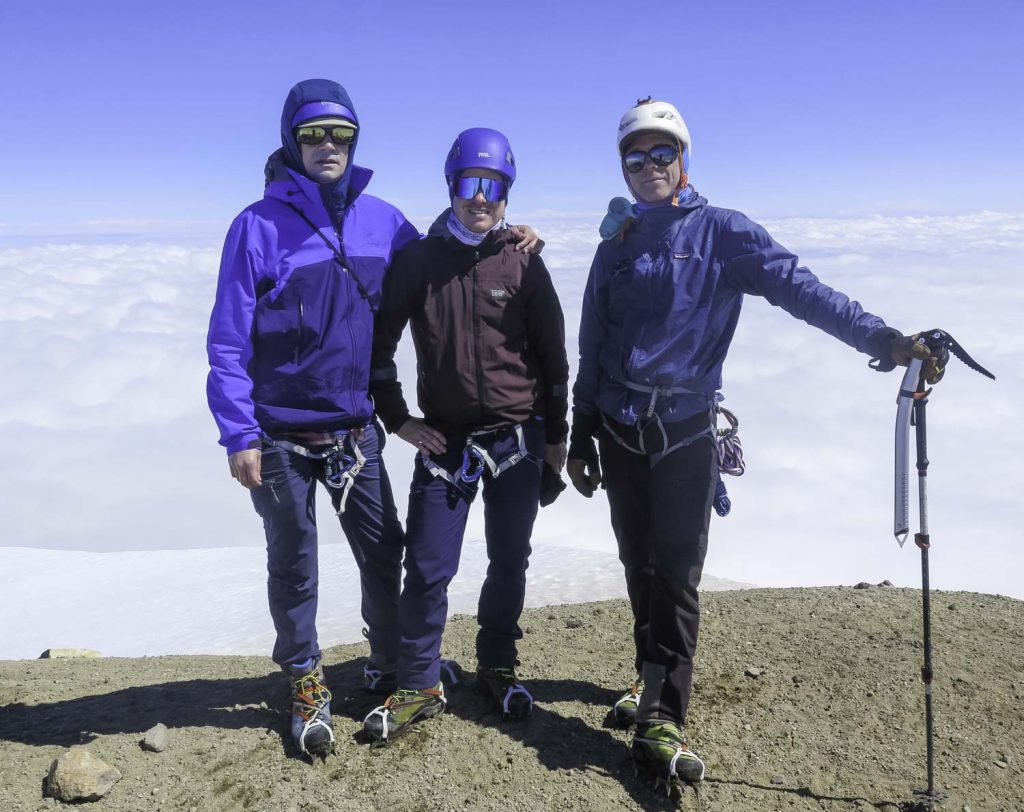
On the way down, Jere explains the inspiration for choosing the name Guided Exposure. He sees his role as helping people become more comfortable and confident in the alpine environment, pushing them to the edge of their comfort zones. With very limited experience on glaciers, there’s no way I would have attempted something like this without a guide. The mountain hides a lot of hazards, from crevasses to avalanches, falling ice and rocks to good old-fashioned hypothermia. But with the help of a guide who capably explains how we are eliminating or mitigating these hazards, I never felt unsafe. There is no point during the climb where I regret being on the mountain or find myself having second thoughts about what I’m doing.
The time I spent preparing for the climb, sweating up hills with a pack full of rocks, had paid off. The walk down is long, and my feet are tired by the time we get back to camp, but I’m deeply satisfied. I find myself again sitting on the big rock, enjoying the sounds of running water and wind blowing gently along the slope. Clouds dance overhead, between me and the summit. Just yesterday, I’d been looking up at the mountain, wondering what I would find and feel, while climbing over ice, rock, and snow to get to the top. And now, gazing up from the same rock, I feel connected in a new way to what was hidden in the clouds.
Over the following weeks, from my hometown of Bellingham, I see Mt. Baker’s snowy summit over the hills to the east. Now, I can’t help but look at the mountain a little differently. Having stood on the summit, I can visualize the contours of the Coleman Glacier and recall feeling the sunshine on my face while standing above the clouds. I can smell the volcanic sulfur steaming from the crater, a reminder of the ongoing activity of the world around us. And I remember feeling confident ascending the Roman Wall and crossing miles of snow-covered ice. The mountain reminds me that I can do hard things when I set my mind to it, that training, practice, and planning can lead to great things, and that there are opportunities all around us. With effort, we can reach goals and overcome the challenges that life presents us.
One step at a time.
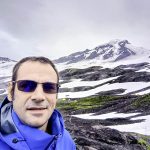 Chris D’Onofrio has spent most of his life living in Bellingham and enjoying the natural beauty of the Pacific Northwest’s mountains, forests, islands, coasts, and waterways. He looks forward to the arrival of each new season and uses the term “within walking distance” loosely.
Chris D’Onofrio has spent most of his life living in Bellingham and enjoying the natural beauty of the Pacific Northwest’s mountains, forests, islands, coasts, and waterways. He looks forward to the arrival of each new season and uses the term “within walking distance” loosely.
 AdventuresNW
AdventuresNW


